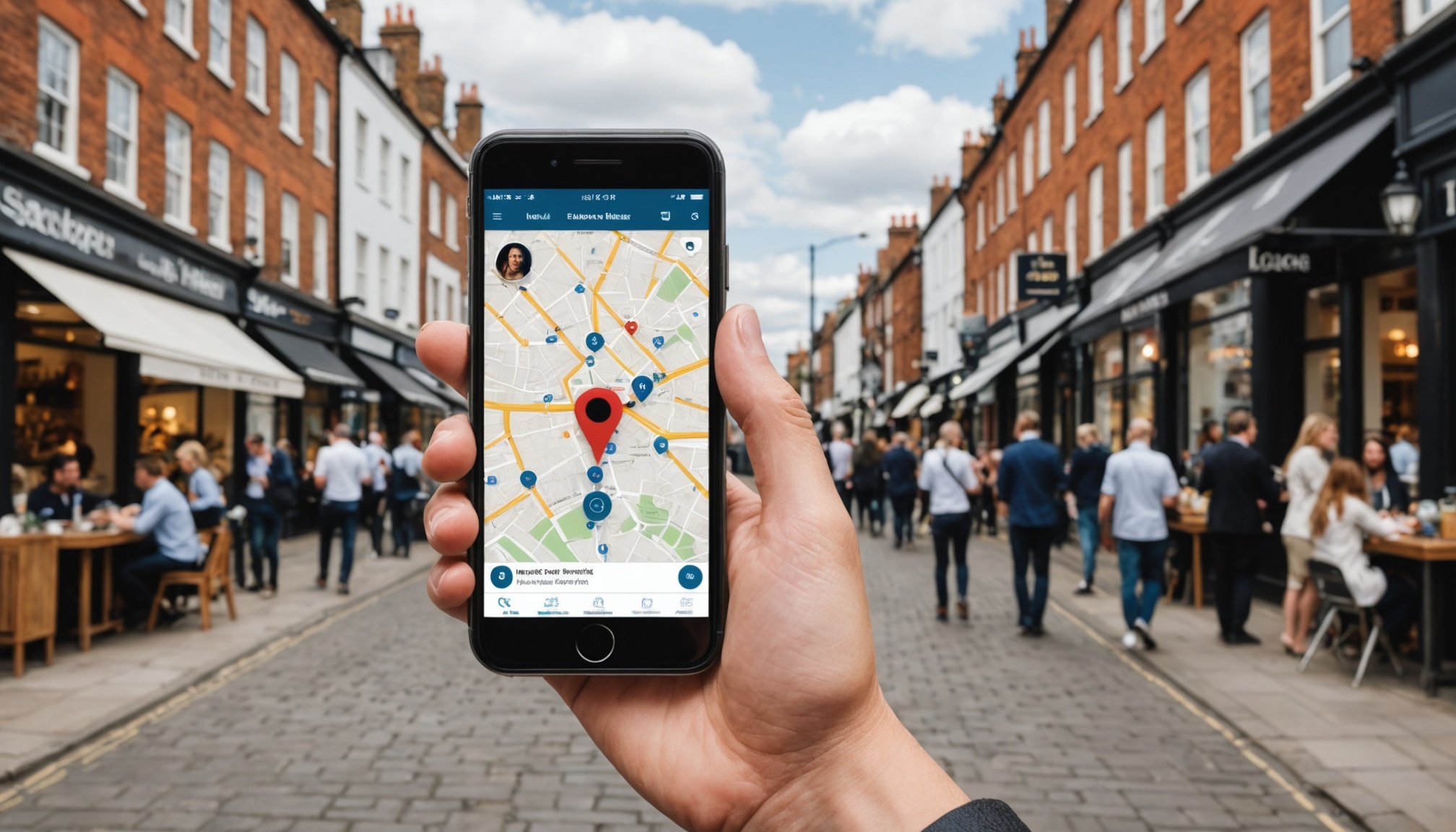Overview of Geofencing Technology
Geofencing technology creates virtual boundaries that trigger actions when devices enter or exit specific areas. At its core, geofencing relies on GPS, Wi-Fi, RFID, or cellular data to establish these perimeters.
In the context of marketing, geofencing plays a transformative role by allowing businesses to target consumers within precise locations. For instance, local marketing strategies can leverage geofencing to deliver personalised promotions or notifications when potential customers are near a store. This not only increases customer engagement but also drives foot traffic, offering a significant advantage in today’s competitive retail environment.
For local businesses, adopting geofencing technology is crucial. It facilitates hyper-local advertising, enabling companies to reach their audience at the right place and time. Geofencing allows businesses to tailor promotions based on shopper behaviour and proximity. From sending a discount coupon as a customer walks by to reminding them of an ongoing sale, the possibilities are vast.
In conclusion, understanding the mechanism and advantages of geofencing is essential for any business aiming to enhance its local marketing efforts. This technology overview emphasises how establishing these digital barriers can lead to more effective customer engagement and increased sales potential.
Also to discover : Maximize your gmail experience with proxy services
Benefits of Geofencing for Local Businesses
Geofencing offers numerous advantages for local business growth, particularly in marketing strategies. By leveraging geofencing’s capabilities, businesses can engage in targeted marketing to enhance customer engagement. This technology allows businesses to send personalized offers to potential customers when they enter a specific geographic area. Such personalization not only increases the chances of attracting customers but also builds customer loyalty by making them feel valued.
Another critical benefit lies in its cost-effectiveness. Traditional advertising methods can be expensive and reach a broad audience, including those unlikely to visit a business. However, geofencing refines this approach by directing promotional efforts toward individuals within proximity to the store. This form of advertising maximizes resource utilization and ensures a greater return on investment.
Moreover, by adopting geofencing, companies can provide an enhanced customer experience. Personalized marketing approaches mean customers receive offers relevant to their preferences, improving satisfaction and increasing the likelihood of purchase. For instance, a local café might offer discounts on a rainy day to nearby users, capitalizing on immediate needs and interests.
In summary, by utilizing geofencing, local businesses can enjoy several marketing advantages, which translates to increased growth and stronger relationships with their clientele. It’s a modern approach to the age-old challenge of attracting and retaining customers effectively.
Steps to Implement Geofencing
Implementing geofencing can seem complex, but with a structured approach, it becomes manageable and effective.
Identifying Business Objectives
The first step in geofencing implementation is to determine your business objectives. Ask yourself what you aim to achieve with geofencing. Is it increased foot traffic to a retail store, enhanced customer engagement, or more precise marketing integration? Pinpointing your goals helps shape the subsequent steps and ensures the setup process aligns with your business strategy.
Choosing the Right Technology Platforms
Selecting the right technology platforms is crucial in the setup process. You’ll need a platform that supports geofencing implementation and offers compatibility with your existing systems. Popular options include mobile ad networks, CRM systems, and dedicated geofencing solutions. Ensure the platform integrates seamlessly with your marketing integration tools for streamlined operations and data analysis.
Setting Up Geofences
- Define target locations and radius: Carefully choose the geographical locations and specify the radius for your geofence areas.
- Create relevant content for triggered events: Develop engaging content tailored to trigger when customers enter or exit geofenced areas.
- Monitor and adjust settings based on performance: Regularly review geofencing performance data and fine-tune settings to optimize outcomes.
Efficient geofencing implementation should be precise and adaptable, ensuring that your marketing strategy thrives within defined geographical spaces.
Case Studies of Successful Geofencing Campaigns in the UK
The UK marketing scene has witnessed several remarkable geofencing success stories. Let’s delve into some notable campaigns that cleverly harnessed this technology.
Notable UK Retail Campaign Using Geofencing
A prominent UK retailer implemented a geofencing strategy to boost in-store traffic by targeting potential customers nearby with timely notifications and exclusive offers. This approach led to a remarkable increase in foot traffic and conversion rates as it strategically encouraged consumers already in close proximity to visit the store. Their success lies in understanding consumer habits and crafting offers that align with those preferences, demonstrating the power of location-based marketing.
Successful Local Events with Geofencing
Local events in the UK have embraced geofencing to engage attendees dynamically. Event organizers have utilized this asset to send updates about schedules, facilitate networking, and offer location-specific content to enhance the attendee experience. This results in heightened engagement and satisfaction, proving geofencing’s utility outside of traditional retail.
Lessons from Effective Geofencing Strategies
Effective geofencing strategies exhibit a few critical components. Key lessons include ensuring permissions by obtaining consent to share location data, crafting precise and relevant content, and maintaining clear objectives and metrics to measure success. These practices ensure campaigns are both respectful and engaging for the user, maximizing the potential of geofencing technology in the competitive UK market.
Integrating Geofencing with Other Marketing Strategies
In today’s competitive digital landscape, marketing integration is crucial for businesses to stay ahead. Leveraging multi-channel strategies can significantly enhance the effectiveness of geofencing. By combining geofencing with social media marketing, businesses can target consumers based on their real-time location, encouraging immediate engagement through timely ads.
Imagine a retail store using geofencing to identify nearby customers, then simultaneously deploying a special offer through social media platforms like Instagram or Facebook. Holistic marketing here means creating a seamless customer experience by ensuring messages and offers are consistently delivered across all channels.
Furthermore, the data collected from geofencing can be a valuable asset for crafting personalized email marketing campaigns. By analyzing location-specific data, businesses can tailor their email content to reflect the unique preferences and behaviors of their audience. This ensures high relevance and increases the probability of engagement.
Geofencing also opens up exciting cross-promotional opportunities with local partnerships. For instance, a coffee shop could collaborate with nearby bookshops or gyms, sending joint offers to customers as they enter a shared geofenced area. This strategy not only broadens each business’s reach but also enriches the customer experience, making it both efficient and memorable.
By adopting such multi-channel strategies and tapping into local synergies, businesses can harness the full power of geofencing.
Challenges and Solutions in Geofencing Implementation
Implementing geofencing technology presents several challenges that local businesses must navigate. Commonly faced geofencing challenges include limited technological resources and significant user privacy concerns. Without the right infrastructure, setting up geofences can seem daunting. Businesses may lack the skilled personnel or the software tools required to optimise geofencing effectively.
Moreover, marketing obstacles are frequently encountered, mainly due to privacy concerns. Consumers are increasingly aware of how their data is collected and utilised. This awareness can lead to reluctance in engaging with geofencing-based marketing. Users might feel uneasy knowing their location is constantly monitored, creating a barrier to engagement.
However, practical solutions exist. To overcome technological barriers, businesses can invest in reliable geofencing software and provide training for staff. Aiming for simplicity in user interfaces can also enhance adoption rates among employees. Privacy concerns can be addressed by ensuring transparency. Informing users about data protocols, offering opt-out options, and securing data storage are pivotal practices.
Best practices include:
- Regular updates on privacy policies
- Implementing stringent data security measures
- Tailoring marketing strategies to respect user preferences
By adopting such solutions, businesses can successfully integrate geofencing into their marketing efforts while maintaining consumer trust.













